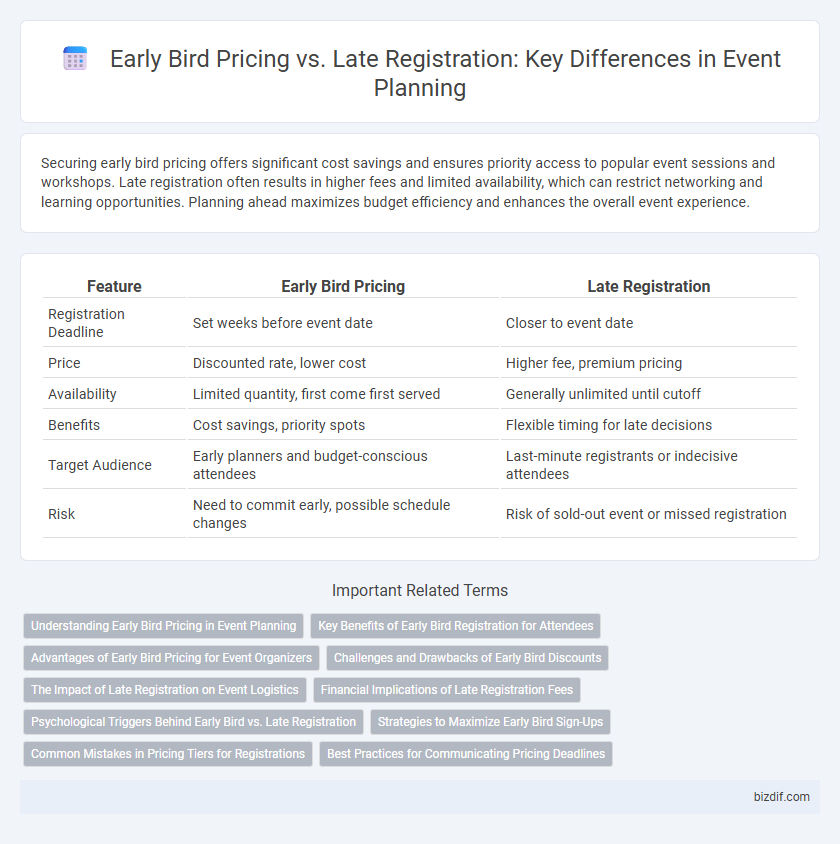Securing early bird pricing offers significant cost savings and ensures priority access to popular event sessions and workshops. Late registration often results in higher fees and limited availability, which can restrict networking and learning opportunities. Planning ahead maximizes budget efficiency and enhances the overall event experience.
Table of Comparison
| Feature | Early Bird Pricing | Late Registration |
|---|---|---|
| Registration Deadline | Set weeks before event date | Closer to event date |
| Price | Discounted rate, lower cost | Higher fee, premium pricing |
| Availability | Limited quantity, first come first served | Generally unlimited until cutoff |
| Benefits | Cost savings, priority spots | Flexible timing for late decisions |
| Target Audience | Early planners and budget-conscious attendees | Last-minute registrants or indecisive attendees |
| Risk | Need to commit early, possible schedule changes | Risk of sold-out event or missed registration |
Understanding Early Bird Pricing in Event Planning
Early bird pricing in event planning offers discounted rates to participants who register well before the event date, incentivizing early commitment and improving cash flow for organizers. This strategy helps predict attendance numbers more accurately, enabling better logistical and budgetary decisions. Conversely, late registration often comes with higher fees, reflecting increased planning costs and limited availability.
Key Benefits of Early Bird Registration for Attendees
Early bird registration offers attendees significant cost savings, often providing discounts of up to 30% compared to late registration fees. Securing a spot early guarantees access to limited-capacity sessions, popular workshops, and exclusive networking events. Early registrants also benefit from extended planning time, ensuring better travel arrangements and accommodation options.
Advantages of Early Bird Pricing for Event Organizers
Early bird pricing incentivizes early commitments, ensuring organizers secure a baseline attendance and improved cash flow months before the event. This strategy allows for more accurate forecasting of resources and budget allocations, minimizing financial risk and enabling better negotiation with vendors. Early bird offers also enhance marketing momentum, creating buzz and driving word-of-mouth promotion that boosts overall registration numbers.
Challenges and Drawbacks of Early Bird Discounts
Early bird pricing can lead to significant cash flow challenges when forecasts are inaccurate, causing either overcommitment or underwhelming attendance. It may also diminish perceived event value, as attendees who register early expect lower costs even if the overall event quality remains high. Late registrants might feel penalized by higher fees, potentially reducing last-minute sign-ups and limiting overall revenue potential.
The Impact of Late Registration on Event Logistics
Late registration complicates event logistics by disrupting accurate attendance forecasting, leading to challenges in resource allocation and vendor coordination. It often results in increased costs due to last-minute adjustments for catering, staffing, and materials. Managing unexpected attendee surges requires flexible planning and contingency strategies to maintain event quality and smooth operations.
Financial Implications of Late Registration Fees
Late registration fees significantly increase the overall cost for attendees, often exceeding early bird pricing by 20-30%, impacting budget planning and attendee affordability. Event organizers capitalize on late fees to offset last-minute administrative costs and potential revenue gaps from early registrations. Understanding these financial implications encourages timely sign-ups, optimizing event cash flow and maximizing participant turnout.
Psychological Triggers Behind Early Bird vs. Late Registration
Early bird pricing leverages the scarcity principle by motivating attendees to secure spots early through discounted rates, creating a fear of missing out (FOMO) that stimulates prompt decision-making. Late registration invokes urgency and loss aversion, as rising prices increase perceived risk of waiting, pushing potential participants to commit despite higher costs. Both strategies tap into cognitive biases like commitment and consistency, encouraging early commitments and reducing no-shows.
Strategies to Maximize Early Bird Sign-Ups
Implement tiered pricing with attractive discounts for early bird registrations to incentivize prompt sign-ups and improve cash flow. Use targeted email campaigns and social media countdowns to create urgency, highlighting limited availability and exclusive perks for early registrants. Leverage data analytics to identify the most responsive segments and tailor personalized offers, optimizing conversion rates before late registration windows open.
Common Mistakes in Pricing Tiers for Registrations
Many event organizers misjudge demand elasticity by setting an early bird pricing tier too close to the standard rate, reducing incentive for early registration and hindering cash flow. Another frequent error involves failing to clearly communicate pricing deadlines, causing confusion and missed opportunities for both attendees and planners. Additionally, neglecting to analyze competitor pricing or audience demographics can lead to poorly optimized tiers that either undercut revenue potential or discourage participation.
Best Practices for Communicating Pricing Deadlines
Clearly display early bird pricing deadlines on all event materials to create urgency and encourage timely registration. Use multiple communication channels, such as email reminders and social media posts, to reinforce the deadline and highlight savings. Ensure messaging emphasizes the financial benefits of early registration while specifying the exact cutoff date to minimize registration confusion.
Early bird pricing vs late registration Infographic

 bizdif.com
bizdif.com